Free E-Mail
Bible Studies
Beginning the Journey (for new Christians). en Español
Old Testament
Abraham
Jacob
Moses
Joshua
Gideon
David, Life of
Elijah
Psalms
Solomon
Songs of Ascent (Ps 120-135)
Isaiah
Advent/Messianic Scriptures
Daniel
Rebuild & Renew: Post-Exilic Books
Gospels
Christmas Incarnation
(Mt, Lk)
Sermon on the Mount
(Mt 5-7)
Mark
Luke's
Gospel
John's Gospel
7 Last Words of Christ
Parables
Jesus and the Kingdom
Resurrection
Apostle Peter
Acts
The Early Church
(Acts 1-12)
Apostle Paul
(Acts 12-28)
Paul's Epistles
Christ Powered Life (Rom 5-8)
1 Corinthians
2 Corinthians
Galatians
Ephesians
Vision for Church
(Eph)
Philippians
Colossians,
Philemon
1
& 2 Thessalonians
1 & 2 Timothy,
Titus
General Epistles
Hebrews
James
1 Peter
2 Peter, Jude
1, 2, and 3 John
Revelation
Revelation
Conquering Lamb of Revelation
Topical
Glorious Kingdom, The
Grace
Great Prayers
Holy Spirit, Disciple's Guide
Humility
Lamb of God
Listening for God's Voice
Lord's Supper
Names of God
Names of Jesus
Christian Art
About Us
Podcasts
Contact Us
Dr. Wilson's Books
Donations
Watercolors
Sitemap
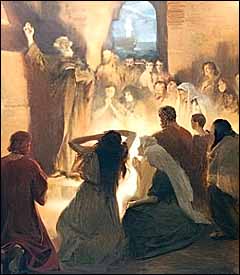 Jan Styka, detail of 'St. Peter Preaching the Gospel in the Catacombs' (1902), Hall of the Crucifixion, Forest Lawn Memorial Park Cemetery in Glendale, California. Full image. |
Once the Apostle Paul arrives in Antioch, attention in the Book of Acts shifts from Peter's foundational ministry, to Paul's ministry throughout the Mediterranean. Peter nearly disappears from Scripture after his key appearance at the Council of Jerusalem about 49 AD. But though he is invisible to us, he is hard at work for the next decade and a half until his death about 64 or 65 AD.
There are clues to what Peter is doing. We'll follow some of them in this lesson. Some of these travels are documented in Holy Scripture, but for some of them we'll need to sort through traditions recorded by the early Church Fathers to determine which seem to be based on fact. We'll also sample some of Peter's teaching by letter.
11.1. Peter's Ministry in Antioch, Asia Minor, and Greece
Peter's Ministry in Antioch
Apparently, beyond Paul's account of a conflict with Peter in Antioch (Galatians 11:14), Peter conducts an important ministry in Antioch, though none of the Scriptures attest to it. Three third century sources -- Origin, Eusebius, and the Apostolic Constitutions -- mention Peter as being the first in succession of patriarchs of Antioch.390
Both Roman and Antiochian traditions credit his ministry there, some saying he founded the church in 34 AD, though Scripture indicates that it was founded by evangelists from Cyprus and Cyrene (Acts 11:19-22), then developed by Barnabas with the help of Paul beginning about 45 AD.391 So far as we know from Scripture, Peter doesn't arrive until about 48 AD (Galatians 2:11-14). Other names than his are mentioned as ministering in Antioch about 47, 49, and 52 AD.392
What should we make of this? Claiming the Apostle Peter as "founder" of your church is important, since leading churches are vying for primacy in later centuries. The churches of Corinth and Rome also claim Peter as founder,393 even though he isn't the first to minister there. But traditions often have some basis in fact.
In light of the traditions, I conclude that St. Peter had some kind of significant ministry in Antioch in the church's early years, perhaps even a formative one. And I don't see any reason to disbelieve that he ordained the first Patriarch or Bishop of Antioch, Evodius (who flourished 50-66 AD).394
Peter's Ministry in Asia Minor
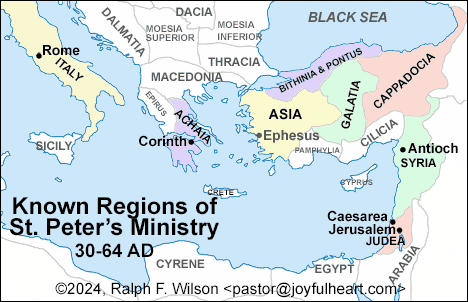 Known Regions of St. Peter's Ministry (30-64 AD). Larger map. |
Peter's First Epistle, written in the early 60s AD, is addressed:
"To those who are elect exiles of the Dispersion in Pontus, Galatia, Cappadocia, Asia, and Bithynia" (1 Peter 1:1)
Thus we can assume that Peter has preached in each of these Roman provinces, an assumption shared by Eusebius writing centuries later.395]5 We know that both Paul and John ministered in the provinces of Asia Minor as well.396 This region must have been a productive field for the apostles.
Peter's Ministry in Corinth
The church at Corinth is founded about 50 to 53 AD under the ministry Paul, Silas, and Timothy (Acts 18:1; 11). A few years later, Peter and his wife seem to have ministered there with considerable impact, for we read:
"One of you says, 'I follow Paul'; another, 'I follow Apollos'; another, 'I follow Cephas'; still another, 'I follow Christ.'" (1 Corinthians 1:12)
"Whether Paul or Apollos or Cephas or the world or life or death or the present or the future-- all are yours." (1 Corinthians 3:22)
Peter's ministry in Corinth seems to have produced a dedicated following, enough for Paul to get a report of these as a distinct group within the church when he wrote his First Corinthians Letter about 55 to 56 AD.
"Don't we have the right to take a believing wife along with us, as do the other apostles and the Lord's brothers and Cephas?" (1 Corinthians 9:5)
This would seem to indicate that Peter and his wife travelled to the various churches in the Mediterranean, including Corinth, with the purpose of establishing them further in Christ.397]7
By about 170 AD, Dionysius, bishop of Corinth, claims Peter as a planter of the church at Corinth, by reason of having "taught us in our Corinth."398 But claiming an apostle as founder because he taught in a church was not uncommon. As mentioned above, Peter is claimed as founder of Antioch, Corinth, and Rome, though he isn't the first to organize Christianity in any of these places.
11.2. Peter's Ministry in Rome
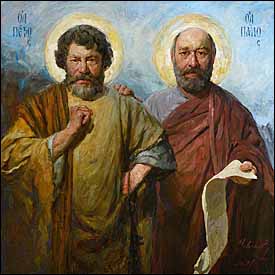 Andrei Nikolaevich Mironov (1975- ), Ryazan, Russia, 'Apostles Peter and Paul' (2021), oil on canvas, 24 x 24 in., artist's collection. Used by permission. |
There is a strong tradition that Peter has significant ministry in Rome prior to being martyred there at the same general time as Paul. Scripture seems to bear that out. I expect that they did work with each other for a time in Rome, though Church traditions concerning this are rather general and quite late.399]9
Babylon = Rome
The First Letter of Peter is written from Rome, probably between 60 and 64 AD.
"She who is in Babylon, chosen together with you, sends you her greetings, and so does my son Mark." (1 Peter 5:13)
"She who is in Babylon" refers to the church in Rome. Babylon, the seat of the ancient oppressor of Israel, is used as a codeword to designate Rome, the current oppressor of God's people.400 We see that both here and in Revelation (probably written three decades later in the mid-90s AD).
By the mid-90s AD, persecutions have claimed the lives of thousands of believers in the city. But for the decade prior to Peter's death, Rome is a fertile site for ministry.
Mark as Peter's Interpreter
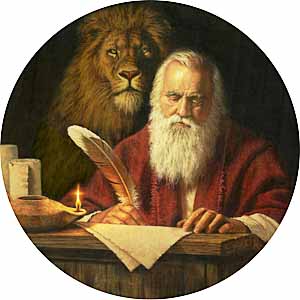 Colbert Gauthier, 'St. Mark the Evangelist' (2024), used by permission of the artist. Larger image. Behind St. Mark is the Lion, his traditional symbol. |
Notice how Peter's greeting includes Mark.
"She who is in Babylon ... sends you her greetings, and d so does my son Mark." (1 Peter 5:13)
Mark is not Peter's biological son, but his spiritual son.
The source of some of our information on the relationship between Peter and Mark comes from early Church Father Papias, Bishop of Hierapolis (60-130 AD), who wrote Exposition of the Sayings of the Lordrd. Unfortunately, it is available to us only in fragments contained in the writings of Irenaeus401 and Eusebius.
Eusebius recites what Papias says he heard from John the Elder (the Presbyter).402
"This also the presbyter [John] said: Mark, having become the interpreter of Peter, wrote down accurately, though not indeed in order, whatsoever he remembered of the things said or done by Christ. For he neither heard the Lord nor followed him, but afterward, as I said, he followed Peter, who adapted his teaching to the needs of his hearers, but with no intention of giving a connected account of the Lord's discourses, so that Mark committed no error while he thus wrote some things as he remembered them. For he was careful of one thing, not to omit any of the things which he had heard, and not to state any of them falsely."403
These words have given Bible scholars much to ponder. "Interpreter" is the Greek noun hermēneutēs, "one who helps someone to understand thoughts expressed in words, translator,"404 or perhaps, "expositor, interpreter."405 Peter could probably speak some Greek, since it was common in Galilee; he wouldn't have known Latin. Probably Peter preached in Aramaic, which would be understood by the Jewish diaspora in Rome. Perhaps Mark translated for Peter to the Gentile audiences who didn't know Aramaic.
Papias says Mark "wrote down accurately, though not indeed in order, whatsoever he remembered of the things said or done by Christ." Apparently, Mark's original notes from Peter's preaching were not in chronological order. Order came later in the process of developing the Gospels. For more on this, see Appendix 4. The Synoptic Problem.
Length of Peter's Ministry in Rome
Just how long was Peter's ministry in Rome? We are pretty sure it ended in 64 or 65 AD with his martyrdom under Nero, at the same time as Paul. But when did his ministry in Rome begin?
Jerome, writing about 400 AD, claims for Peter a twenty-five year ministry in Rome from 43 to 68 AD.406 Jerome has the general idea, but his dates are faulty. Notice that he isn't talking about how long Peter ministered in Rome, but how long he "held the sacerdotal chair," that is, as the first bishop. Perhaps Jerome has an agenda to establish primacy of the Roman bishop. (See Appendix 5. Primacy of Peter vs. Papal Primacy.)
When could Peter's time in Rome have begun? Claudius expelled all the Jews from Rome in 49 AD, his edict only ending with his death in 54 AD. Peter would have been seen as a Jew and would not have been in Rome during this period.
Let's look at the evidence we have from Scripture.
1 Corinthians. We presume from mentions in 1 Corinthians that Peter visited Corinth somewhere between say 52 and 57 AD (see Section 11.1 above).
Letter to Romans. Paul's Letter to the Romans is dated early in 57 AD. In chapter 16, Paul greets by name more than two dozen people now in Rome whom he has met throughout his ministry. Prisca and Aquila have now moved back to Rome following the expulsion of Jews that ended in 54 AD. F.F. Bruce writes:
"A visit to Rome by Peter (perhaps accompanied by Mark) would have helped to give fresh impetus to Christianity in the capital when it revived after the expulsion edict. We have no direct evidence of this, but such a visit has been postulated on independent grounds by various scholars."407
Peter's name is not mentioned among those greeted by name in Romans 16, which would be expected if he had been present in the city at the time of Paul's writing.
I conclude that Peter's ministry in Rome probably began during or after 57AD, giving him a ministry in the city of perhaps five to seven years (if he is there continuously) before his martyrdom in 64 or 65 AD.
11.3. Preaching, Miracles, and Evangelism
A couple of early writers tell a bit about Peter's ministry in Rome. Clement of Alexandria (150-215 AD) wrote,
"When Peter preached the word publicly at Rome, and declared the gospel by the Spirit, many who were present requested that Mark, who had been for a long time his follower and who remembered his sayings, should write down what had been proclaimed."408
Just what did he preach? Probably the life and teachings of Christ that Mark recorded. But he also established the believers with exhortations like we find in 1 and 2 Peter. As mentioned, we know that at least 1 Peter was written from Rome (Babylon).
Lactantius (250-325 AD), an advisor to Emperor Constantine wrote around 318 AD:
"While Nero reigned [54-68 AD], the Apostle Peter came to Rome, and, through the power of God committed unto him, wrought certain miracles, and, by turning many to the true religion, built up a faithful and steadfast temple unto the Lord. When Nero heard of those things ... [he] sprung forward to raze the heavenly temple and destroy the true faith. He it was who first persecuted the servants of God; he crucified Peter, and slew Paul."409
Tradition tells us that for some period, both Peter and Paul were laboring in Rome at the same time.
Peter's teaching of Jesus' gospel, bold preaching, and miracle-working in the very heart of the Roman empire, helps build a strong congregation there, recalling some of the healing evangelism Peter did in Jerusalem, Lydda, and Joppa.
Jesus' promise to Peter decades before, manifests itself in the closing days of his life: "Come, follow me, and I will make you fishers of men" (Mark 1:17).
Another function of Peter's ministry is helping to establish the leadership structure of the church in Rome, ordaining priests and bishops. The late Liber Pontificalis (867 AD; supplemented in the Middle Ages), says that:
"Peter ordained two bishops, Linus and Anacletus, for the priestly service of the community, devoting himself instead to prayer and preaching, and that it was to Clement that he entrusted the Church as a whole, appointing him as his successor."410
According to Irenaeus (180 AD),411 some the early bishops of Rome include:
- Linus (2 Timothy 4:21), served 68 to 80 AD,412 ordained by Paul.413
- Anacletus (Cletus), 80 to 92 AD, who set up about 25 parishes in Rome.414
- Clement of Rome, about 92 to 100 AD, ordained by Peter,415 wrote 1 Clement to the Corinthian church, which is available to us.
- Evaristis (Aristus), about 100 to 108 AD.
The first three of these bishops probably knew Peter and Paul, who helped form their ministry. See also Appendix 5. Primacy of Peter vs. Papal Primacy.
The Liber Pontificalis suggests that Peter spent his time in spiritual ministry -- "devoting himself instead to prayer and preaching" -- rather than the day-to-day pastoral ministry of a bishop administering a congregation. Peter is special. He is an apostle.
While the Roman Catholic Church proclaims Peter to be the first Bishop of Rome, I think this is wrongly stated. Clearly, Peter is an Apostle, giving him a much greater authority than any bishop. With his apostolic authority, Peter apparently does set some people into office in Rome -- but so does Paul.
11.4. Peter's Opposition to False Teachers
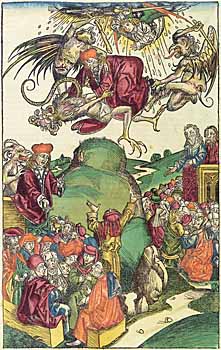 'The Death of Simon Magus' (1493), colored woodcut, illustration from the Nuremberg Chronicle. St. Peter in red bishop's robe and cap is on the left is teaching, also in the sky fighting the dragon in intercessory prayer. Simon is on the right preaching heresy to the people. According to the apocryphal Acts of Peter, Simon levitates into the air at the Roman forum to appear as a god. Peter prays to stop his flying and he falls, breaking his legs in three parts.416 Larger image. |
You may not have thought about St. Peter in this way, but one of his major roles later in life is to combat the false teaching that springs up around the new Christian faith in cities all over the Mediterranean. Just as Paul has to confront the legalists of the circumcision party, Peter has to take a stand also.
The Legend of Simon Magusagus
You'll recall that Peter sternly rebuked Simon the Magician in Samaria (about 37-38 AD, Lesson 8.5). According to church tradition, Simon Magus leaves the backwater city of Samaria and comes to Rome, becoming the head of a widespread heresy. There he is rebuked in Rome by Peter once more.417
I don't see enough consistency in this legend of Simon Magus in Rome to associate it with the historical Simon Magus of Samaria. However, it wouldn't surprise me, if the Simon Magus in Rome legend might have some basis in fact. An early Gnostic heretical group was known as the Simonians.418
Condemnation of False Teachers (2 Peter)
From the Letter of Second Peter, it's pretty obvious that Peter seeks to protect the church from false teachers through his patient teaching. Let me give you just a bit of his denunciation of these false teachers, some of which is echoed in the Letter of Jude.
"1 There were also false prophets among [God's] people, just as there will be false teachers among you. They will secretly introduce destructive heresies, even denying the sovereign Lord who bought them -- bringing swift destruction on themselves. 2 Many will follow their shameful ways and will bring the way of truth into disrepute. 3 In their greed these teachers will exploit you with stories they have made up." (2 Peter 2:1-3a)
These false teachers are spinning opinions in order to get people to give them money. Compared to Peter's emphasis on holiness of life, these false teachers encourage immorality by their actions.419
Long before, Peter had heard Jesus say, "By their fruits you shall know them" (Matthew 7:16a). Now Peter is watching out for them and warning his people. He concludes his Second Letter with these words:
"Be on your guard so that you may not be carried away by the error of lawless men and fall from your secure position. But grow in the grace and knowledge of our Lord and Savior Jesus Christ. To him be glory both now and forever! Amen" (2 Peter 3:17b-18)
11.5. Peter's Teachings on Practical Christian Living (1 Peter)
While Peter stands against heretics, he doubtless spends a great deal of time establishing believers in basic Christian living. To see this fully, study 1 and 2 Peter. Here are just a few of the themes Peter emphasizes in his letters.
The Theme of Priesthood (1 Peter 2:5, 9)
Twice within a brief passage in 1 Peter, Peter speaks of believers as priests.
"But you are a chosen people, a royal priesthood, a holy nation, a people belonging to God, that you may declare the praises of him who called you out of darkness into his wonderful light." (1 Peter 2:9)
Historically, these verses describing all Christians as priests made a great impact on Martin Luther (1483-1546) who sought reform in the Roman Catholic Church. Rather than a select order of ordained priests in the Church, Luther had a vision of all of God's people being able to relate to God directly through the medium of the Holy Spirit (1 Corinthians 2:8-16) -- "the priesthood of believers."
Peter has a wonderful view of the church -- individual believers as "living stones" who are built together into a temple where God is worshipped (1 Corinthians 3:16).
"You also, like living stones, are being built into a spiritual house to be a holy priesthood, offering420 spiritual421 sacrifices422 acceptable423 to God through Jesus Christ." (1 Peter 2:5)
Just what kinds of offerings do we priests offer to God? Here are a few.
1. Obedience. When we obey God in the way we live, we worship God. "Offer your bodies as living sacrifices, holy and pleasing to God -- this is your spiritual act of worship" (Romans 12:1; cf. Matthew 6:1-5). The Psalmist says, "May the words of my mouth and the meditation of my heart be pleasing in your sight, O Lord, my Rock and my Redeemer" (Psalm 19:14).
2. Financial Gifts. New Testament sacrifices include financial offerings for the poor (Philippians 4:18; Hebrews 13:16).
3. Proclaiming the Gospel. Paul talks about his call "to be a minister of Christ Jesus to the Gentiles with the priestly duty of proclaiming the gospel of God, so that the Gentiles might become an offering acceptable to God, sanctified by the Holy Spirit" (Romans 15:16).
4. Praise. "Through Jesus, therefore, let us continually offer to God a sacrifice of praise -- the fruit of lips that confess his name" (Hebrews 13:15, from Hosea 14:2, KJV), "the calves of our lips"). Old Testament priests offered animal, grain, and incense offerings; New Testament priests offer praise. Here is our purpose: "... that you may declare the praises of him who called you out of darkness into his wonderful light"424 (1 Peter 2:9b).
The Theme of Holiness
One of Peter's major themes in 1 Peter is personal holiness. I can almost feel Peter's heart as he sees the results of sin in the lives of believers.
"Dear friends, I urge you, as aliens and strangers in the world, to abstain from sinful desires, which war against your soul." (1 Peter 2:11)
Sin destroys lives and families. It alienates loved ones. Sins, says Peter, "wage war425 against the soul" (KJV). If we give ungodly desires full rein, they beat up our soul, shred any spiritual life, and leave us wounded.
There's no way to treat Peter's full teaching in the space we have, but here are a few excerpts.
"14 As obedient children, do not conform426 to the evil desires you had when you lived in ignorance. 15 But just as he who called you is holy, so be holy in all you do; 16 for it is written: 'Be holy, because I am holy.'"427 (1 Peter 1:14-16)
Holiness is Spirit-empowered resistance to sin and conformity to Christ.
The Hebrew word qādesh is translated "holy, holiness." The root is best understood as serving to delineate the sphere of the "holy" or "sacred" from the profane or common.428]428 God is holy and separate from sinful mankind. But so are those who are dedicated wholly to him. Moses, the priests, and Levites are ordained and set apart to serve God exclusively. Their garments, their food, and everything they touch while "on duty" is set apart to God. They belong to the Lord in a full and unique way. They are "devoted" to God's service exclusively.
God is morally pure and righteous. Isaiah the prophet writes:
"The Lord Almighty will be exalted by his
justice,
and the holy God will show himself holy by his righteousness." (Isaiah 5:16)
The process of becoming more like God, that is, becoming more holy in our character, is called "sanctification" or "discipleship." Holiness involves obedience.
"Now that you have purified yourselves by obeying the truth so that you have sincere love for your brothers, love one another deeply, from the heart." (1 Peter 1:22)
Q56. (1 Peter 1:14-16, 22; 2:11) How does indulging in sin "wage war" against our souls? What are the results in our inner person when we indulge in sin rather than immediately repent? What does it mean to be holy?
The Theme of Submission (1 Peter 2:13-3:7)
If you've studied Paul's teaching in 1 Timothy and Titus, you know the struggle to get new converts from paganism to begin to live decent, loving lives, free of slavery to lust and alcohol. Lives that bring credit to Christ and this new faith of Christianity. Peter is no different. In 1 Peter 2:13-3:7 he devotes quite a bit of time instructing the believers about appropriate submission, that is, voluntarily placing oneself under another person. He begins:
"13 Submit yourselves for the Lord's sake to every authority instituted among men: whether to the king, as the supreme authority, 14 or to governors, who are sent by him to punish those who do wrong and to commend those who do right. 15 For it is God's will that by doing good you should silence the ignorant talk of foolish men." (1 Peter 2:13--15)
Followers of Jesus need to be seen as good citizens in the community.
Then he goes on to explain what submission looks like within a household. Such instructions, known by the German term Haustafel, are found elsewhere in the New Testament429]429 to give guidance to household relationships:
- Slaves and masters (1 Peter 2:18-20; Ephesians 6:5-8; Titus 2:9)
- Wives and husbands (1 Peter 3:1-7; cf. Ephesians 5:22-33; Colossians 3:18-19)
The Theme of Following in Jesus' Steps (1 Peter 2:21-25)
One passage in 1 Peter talks about a slave who sometimes receives an unjust beating for something he didn't do -- no doubt a very common occurrence. Peter uses Christ as an example of suffering without retaliation.
"21b Christ suffered for you, leaving you an example,430 that you should follow in his steps.431
22 'He
committed no sin,
and no deceit was found in his mouth.'
23 When they hurled their insults432 at him, he did not retaliate;433 when he suffered, he made no threats.434 Instead, he entrusted himself to him who judges justly." (1 Peter 2:21-23)
They reviled and abused our Lord. Exactly what did Jesus do when under the pressure of unjust rulers and soldiers, Pharisees and other enemies? What he didn't do is remarkable:
1. He doesn't sin with his words. That is so incredibly hard to achieve when evil people are badgering us!
2. He doesn't deceive his enemies. In self-defense sometimes we resort to half-truths. Not Jesus. He is open and honest under pressure, even though he knows his words will be twisted by his enemies.
3. He doesn't retaliate. The saying, "Turn about is fair play," doesn't come from the Bible, but from the book of human weakness. There's a warped satisfaction in telling someone off. Jesus resists the temptation.
4. He doesn't threaten. I can hear Christians railing after their persecutors -- "God is going to send you to hell for this!" That isn't the Spirit of God, but a spirit of hatred. If we really understand hell, we'll only mention it with tears and sorrow for those who will go there, not gloating. We aren't to threaten, for it brings great disrepute upon the name of Christ!
5. He does trust his Father. "He entrusted435 himself to him who judges justly" (1 Peter 2:20). Jesus is at peace under pressure, persecution, and suffering because he trusts his Father to right all wrongs, to take care of his spirit, and to bring about the Father's perfect will for all mankind. We must claim that peace that comes only through trust.
This idea "that you should follow in his steps" is powerful also. With Christ as our example, what does it mean in our world today to "follow in his steps." In 1896, Charles Shelton wrote In His Steps: What Would Jesus Do? The book sold 30 million copies. Then in the 1990s, a Michigan youth group leader read the book and was inspired to get her youth to incorporate it into their lives. So she had printed 300 "friendship bracelets" bearing the letters WWJD (for "What would Jesus do?") for her young people. The idea spread around the world.
I believe that the basic idea of discipleship is walking with Jesus day by day, hence my domain name, JesusWalk.com. Following in his steps carries the same thought. He is our example. How would Jesus handle this situation? If I apply his teachings, how should I respond here. Disciples follow in Jesus' steps!
Q57. (1 Peter 2:21-25) Why is the question, "What would Jesus do?" so powerful? How do you implement in your daily life the idea of "following in his steps"?
These are just some of the themes that Peter teaches the new believers in Rome and elsewhere.
11.6 Peter's Death by Crucifixion
By the time Peter is writing 2 Peter, you can tell that he realizes that his death will come soon. His teaching, his words of Jesus are to be his legacy.
"I know that the putting off of my body will be soon, as our Lord Jesus Christ made clear to me. And I will make every effort so that after my departure you may be able at any time to recall these things." (2 Peter 1:14-15, ESV)
Rome has become a dangerous place for followers of Jesus, especially for leaders of the Christian movement.
The Quo Vadis Legend
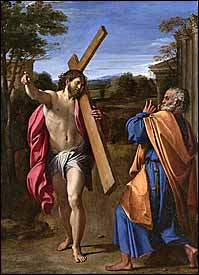 Annibale Caracci, 'Domine Quo Vadis' (1602), oil on panel, 30x22 in, National Gallery, London. |
The apocryphal Acts of Peter (written about 200 AD) tells the story of Peter being threatened by death for encouraging several Roman wives and concubines to a life of chastity. When he hears of the plot against his life, Peter flees. According to legend, as Peter is leaving the city, he encounters Jesus along the Appian Way. Peter asks him "Quo vadis? Where are you going?" Jesus replies, "I am going to Rome to be crucified again." This gives Peter courage to return to Rome to face martyrdom by crucifixion.436 Today a small church marks the spot where this is presumed to have occurred.437 Personally, I don't find this legend credible; it is not widely reported by the early Church Fathers.
Rome Burns; Christians Are Blamed
An horrific persecution of Christians is precipitated by a huge conflagration in Rome. On the night of July 18-19, 64 AD a fire begins in the region of the Roman circus and consumes half the city before it is brought under control after six days. Various stories circulate about the fire's cause. Several hold Nero responsible. Some record him playing his lyre as he watches the fire. Others have him out of town in Antium. Others credit it to an accident.438
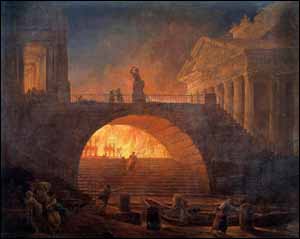 Hubert Robert, 'Fire in Rome' (1785), oil on canvas, 76x93 cm., Musee des Beaux-Arts Andre Malraux, La Havre, France. |
Roman historian Tacitus (56-120 AD) tells us that after the fire, Nero brings in food supplies and opens places to accommodate the refugees. Of Rome's fourteen districts only four remain intact. Three are leveled to the ground. The other seven are reduced to a few scorched and mangled ruins.
It is a terrible tragedy! But then it gets blamed on the Christians. Tacitus says the public believes that the fire is the result of an order by Nero. Here is his conclusion, penned about 117 AD:
"Consequently, to get rid of the report, Nero fastened the guilt and inflicted the most exquisite tortures on a class hated for their abominations, called Christians by the populace."439
Anyone considered as a leader of the Christians in Rome would be subject to arrest and death. We assume that both Peter and Paul are arrested and are in custody in Rome sometime in 64 or 65 AD. According to tradition, both Peter and Paul are imprisoned for a time in the Mamertine Prison.440
All over the city, "an immense multitude" is convicted and punished with horrible deaths. Tacitus continues:
"Mockery of every sort was added to their deaths. Covered with the skins of beasts, they were torn by dogs and perished, or were nailed to crosses, or were doomed to the flames and burnt, to serve as a nightly illumination, when daylight had expired."
Tacitus concludes that the gruesome spectacle succeeded in producing "a feeling of compassion" for the Christians.441
Peter's Crucifixion
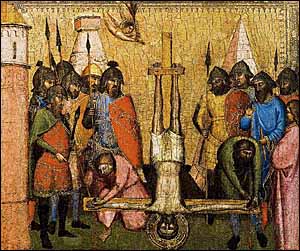 Jacopo Di Cione, 'San Pier Maggiore Altarpiece: The Crucifixion of St Peter' (1370-71), tempera on wood, 35 x 42 cm Pinacoteca, The Vatican. |
As a Roman citizen, the Apostle Paul would have met a quick death by beheading.
But in this time of national crisis, those Nero accused of being leaders among the Christians would be killed slowly, cruelly, and publicly. Being burned alive was horribly painful, but only for minutes. Crucifixion killed a person by suffocation over a period of days, as they became too weak to pull up their body so they could fill their lungs with air.
At the end of John's Gospel, following Jesus' restoration of Peter, the Master gives Peter this prophecy (see Lesson 6.5).
"18 'I tell you the truth, when you were younger you dressed yourself and went where you wanted; but when you are old you will stretch out your hands, and someone else will dress you and lead you where you do not want to go.' 19 Jesus said this to indicate the kind of death by which Peter would glorify God. Then he said to him, 'Follow me!'" (John 21:18--19)
John includes this aside, "Jesus said this to indicate the kind of death by which Peter would glorify God." In other words, Jesus intends to point to Peter's crucifixion -- "you will stretch out your hands," the posture of crucifixion.
Outside the New Testament, several early Christian writers testify to Peter's crucifixion.442 There seems to be nearly unanimous agreement among the Church Fathers that Peter is executed by crucifixion in Rome under Nero. According to one tradition, Peter is crucified upon the hill of Janiculum. A more likely tradition makes the scene of execution on the Vatican hill where Nero's circus was.443
By about 200 AD, an account in the Acts of Peter describes Peter's crucifixion as upside down, repeated by Eusebius (324 AD) and by Jerome (396 AD). I find it attractive and would like to believe it, but upon investigation I don't find it really credible. (For more on this, see Appendix 6. The Legend of Peter's Upside-Down Crucifixion.)
11.7. Peter's Exalted View of Jesus (1 Peter)
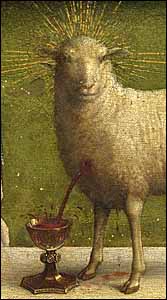 Jan van Eyck, detail of 'Adoration of the Lamb' (1432), oil on wood, Ghent altarpiece, Cathedral of St. Bavo, Ghent. |
We've reached the end of St. Peter's life and reflected upon his growth as a disciple as well as his powerful influence as a foundational apostle.
Peter may have begun his disciple-life as a rather obtuse but vocal follower. However, he concludes his life as a wise, thoughtful teacher of Jesus -- not only of Jesus' teachings, but of who Jesus is, how to understand Jesus.
I am concluding this study of the Apostle Peter with a quick dip into three passages about the meaning of Jesus' death. Three different ways we can see him as our Savior. This is an important theme for Peter.
- Jesus as the Lamb of God (1 Peter 1:18-21)
- Jesus as the Sin-Bearer (1 Peter 2:24-25)
- Jesus as our Atoning Sacrifice (1 Peter 3:18a)
1. Jesus as the Lamb of God (1 Peter 1:18-21)
The first of these recalls John the Baptist's words spoken decades previously: "Behold, the Lamb of God who takes away the sin of the world" (John 1:29). Peter's brother Andrew had heard him say it! (Lesson 1.1).
In his First Epistle, Peter explores Jesus as this sacrificial Lamb of God.
"18b You were redeemed .... 19 with the precious blood of Christ, a lamb without blemish or defect. 20 He was chosen before the creation of the world, but was revealed in these last times for your sake. 21 Through him you believe in God, who raised him from the dead and glorified him, and so your faith and hope are in God. (1 Peter 1:18--21)
In these three verses, Peter helps us see Jesus as:
- Redeemer,
- Lamb of God,
- Preexistent One, and
- Risen Lord.
2. Jesus as the Sin-Bearer (1 Peter 2:24-25)
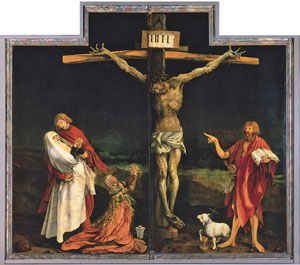 Matthias Grünewēald, 'Crucifixion' panel of the Isenheim Altarpiece (1512--15); in the Musée d'Unterlinden, Colmar, France. |
A second image is as a sin-bearer. Jesus' enemies considered their persecution and crucifixion as a success. They had put an end to the pesky man of God who threatened them and the status quo. But on the cross, that instrument of death, unbeknownst to his persecutors, a transfer, a transformation takes place. In his death, Jesus bears the sins and the penalty for sins of all mankind.
"24 He himself bore our sins in his body on the tree, so that we might die to sins and live for righteousness; by his wounds you have been healed. 25 For you were like sheep going astray, but now you have returned to the Shepherd and Overseer of your souls." (1 Peter 2:24-25)
Peter teaches here what theologians call the "substitutionary atonement." Jesus takes on himself the punishment we deserved. He takes our place as our substitute. Thus, he atones for our sins -- freeing us! "The tree" as a term for the cross, is a way of pointing to Jesus bearing the curse of the death penalty for us,444 a symbol that Peter has used in his preaching in Jerusalem (Acts 5:30; 10:39). Perhaps the simplest phrase to describe his taking our sins on himself is from the great Suffering Servant passage of Isaiah 53 that formed Jesus' own understanding of his death.
"By his wounds445
you have been healed."446
(1 Peter 2:24c, quoting Isaiah 53:5d)
Peter concludes his reference to Isaiah 53 with this verse:
"For you were like sheep going astray,
but now you have returned
to the Shepherd and Overseer of your souls." (1 Peter 2:25)
The straying sheep have returned to their Shepherd, who will watch over them with love. With this analogy, and title of Jesus, Peter helps expand our understanding of who Jesus is and how he cares for us. For Peter, Jesus is:
- Our Prime Example,
- Sinless,
- Sin-bearer,
- Healer from Sins, and
- Shepherd and Overseer of our souls.
Q58. (1 Peter 2:24-25) In what sense did Jesus die for our sins? In what sense is he your Shepherd now? What does this relationship require of you?
3. Jesus as our Atoning Sacrifice (1 Peter 3:18a)
A third image Peter gives us is along the same lines of atonement as lamb and sin-bearer. Peter reminds his readers of Jesus' righteousness and sinlessness in the face of his own death, as an example to us.
"Christ died for sins once for all, the righteous for the unrighteous, to bring you to God." (1 Peter 3:18)
In this verse, Peter gives us some important lessons about the redemptive power of Jesus' suffering for us.
1. Christ died for sins, he is killed for our sins.447
2. Once for all.448 Sometimes we feel like we need to be forgiven all over again. But Christ's atonement has been made once for all, with no need to ever be repeated again.449
3. The righteous for the unrighteous. Peter has already established that "He committed no sin."450 In our case, the Righteous One substitutes himself to die for the sins of the unrighteous ones -- all of us humans. This is a clear example of a substitutionary view of the atonement.
4. To bring you to God. Jesus' purpose451 is clear -- to bring us to God.452 What does that mean? It means to be reconciled to God (Ephesians 2:16), to have access to the Father (Ephesians 2:17), to approach the throne of grace with confidence (Hebrews 4:16), to be purified from sin so we can approach God (Hebrews 10:22), to have peace with God (Romans 5:1; Colossians 1:20).
Q59. (1 Peter 3:18a) Meditate for a few minutes on this verse: "For Christ died for sins once for all, the righteous for the unrighteous, to bring you to God." Now personalize it to imagine (1) your sins, (2) your unrighteousness, and (3) your reconciliation with God. Each of these ideas is awesome! Which of these three aspects of the verse has God impressed most strongly on you today?
As Peter combats heresy in Rome and elsewhere, he holds up Jesus as our wonderful Savior. In fact, Jesus is our only and indispensable Savior:
"Salvation is found in no one else, for there is no other name under heaven given to men by which we must be saved." (Acts 4:12)
We've come to the close of our study. At the beginning, we see Peter as a fascinating fisherman who is both bold and vacillating, strong and weak. Then at Pentecost, the Holy Spirit seems to change him. He's not perfect. He makes mistakes. But he is different. He becomes known for his powerful preaching and miracles. His evangelism and nurturing new believers. His two short letters, written near the end of his life, are full of rich insights drawn from a lifetime of pondering the person of Jesus and the meaning of his death. Peter has become the rock Jesus had foreseen him to be, the rock that became foundational for Christ's Church.
 Available in book versions: paperback, PDF, and Kindle |
When we look at the younger Peter, we can easily see in him our own doubts and fears and weaknesses. But look beyond him to the Peter who is filled with the Holy Spirit. Identify with this Peter and see in him an example of what the Holy Spirit can do with your life as you walk surrendered to him.
Prayer
Father, thank you for the life and ministry of Peter. Thank you for his courage, for his faith. For his willingness to get back up and try again. Thank you that he was willing to walk in the Spirit as a model for us. Help us to live for you as Peter did. In Jesus' name, we pray. Amen.
Lessons for Disciples
As we review Peter's later ministry, teaching, and death, we find several lessons.
- Peter ministers in Judea, Samaria, along the Judean coast, in Antioch, Asia Minor, Corinth, and Rome, performing miracles, preaching and drawing people to Jesus, and establishing them as disciples of Christ (1 Peter 1:1, §11.1).
- Particularly in Rome, Mark becomes Peter's scribe and interpreter, helping to form the Gospels (1 Peter 5:13, §11.2).
- Peter may have ministered in Rome between about 57 to 64 AD, and wrote 1 Peter from Rome (as "Babylon," the new world power's capital; 1 Peter 5:13, §11.2).
- According to tradition, Peter performed miracles in Rome and declared Christ, drawing thousands to follow Jesus. He also ordained Clement who later became bishop of Rome (§11.3).
- Legend has Peter combating heresy in Rome (2 Peter 2:1-3; §11.4).
- Peter seems to have had a heart for teaching practical Christian living to those he wins to Christ, such as the priesthood of all believers (1 Peter 2:5, 9, §11.5).
- Another theme is holiness of life in contrast to conformity to the sinful lifestyle of the world (1 Peter 1:14-16, 22; 2:11, §11.5).
- Peter also taught the need for submission to secular authorities as well as to husbands and masters, this in contrast to rebelliousness (1 Peter 2:13-3:7, §11.5).
- Another theme is following Jesus' example in daily life, "following in his steps" -- in particular as we struggle against injustice and persecution (1 Peter 2:21-25, §11.5).
- Jesus prophesied that Peter would die by crucifixion, and this is the unanimous witness of tradition, that Peter died by crucifixion under Emperor Nero about 64 or 65 AD (John 21:18-19, §11.6).
- 1 Peter develops the meaning of Jesus' death with three passages that discuss Jesus as the Lamb of God, as the Sin-Bearer, and as our Atoning Sacrifice (1 Peter 1:18-21; 2:24-25; 3:18a, §11.7).
Key Verses
"Be on your guard so that you may not be carried away by the error of lawless men and fall from your secure position. But grow in the grace and knowledge of our Lord and Savior Jesus Christ. To him be glory both now and forever! Amen" (2 Peter 3:17b-8, NIV)
"You also, like living stones, are being built into a spiritual house to be a holy priesthood, offering spiritual sacrifices acceptable to God through Jesus Christ." (1 Peter 2:5, NIV)
"You are a chosen people, a royal priesthood, a holy nation, a people belonging to God, that you may declare the praises of him who called you out of darkness into his wonderful light." (1 Peter 2:9, NIV)
"As obedient children, do not conform to the evil desires you had when you lived in ignorance. But just as he who called you is holy, so be holy in all you do; for it is written: 'Be holy, because I am holy.'" (1 Peter 1:14-16, NIV)
"Dear friends, I urge you, as aliens and strangers in the world, to abstain from sinful desires, which war against your soul." (1 Peter 2:11, NIV)
"Submit yourselves for the Lord's sake to every authority instituted among men: whether to the king, as the supreme authority, or to governors, who are sent by him to punish those who do wrong and to commend those who do right. For it is God's will that by doing good you should silence the ignorant talk of foolish men." (1 Peter 2:13--15, NIV)
"Christ suffered for you, leaving you an example, that you should follow in his steps." (1 Peter 2:20b, NIV)
"'I tell you the truth, when you were younger you dressed yourself and went where you wanted; but when you are old you will stretch out your hands, and someone else will dress you and lead you where you do not want to go.' Jesus said this to indicate the kind of death by which Peter would glorify God. Then he said to him, 'Follow me!'" (John 21:18--19, NIV)
"You were redeemed .... with the precious blood of Christ, a lamb without blemish or defect. He was chosen before the creation of the world, but was revealed in these last times for your sake. Through him you believe in God, who raised him from the dead and glorified him, and so your faith and hope are in God. (1 Peter 1:18--21, NIV)
"He himself bore our sins in his body on the tree, so that we might die to sins and live for righteousness; by his wounds you have been healed. For you were like sheep going astray, but now you have returned to the Shepherd and Overseer of your souls." (1 Peter 2:24-25, NIV)
"Christ died for sins once for all, the righteous for the unrighteous, to bring you to God." (1 Peter 3:18, NIV)
End Notes
[390] Origin of Alexandria (185--253 AD) refers to: "... Ignatius, the second bishop of Antioch after Peter...." (Origin, Homily VI on Luke). Eusebius (260--340 AD) also includes a mention in his Church History. He talks about several contemporaneous saints -- Polycarp, Papias, and Ignatius: "Ignatius, who was chosen bishop of Antioch, second in succession to Peter, and whose fame is still celebrated by a great many" (Church History, 3.36.2). The Apostolic Constitutions (Syria, 375-380 AD), purporting to be written by Peter, records: "Now concerning those bishops which have been ordained in our lifetime, we let you know that they are these: ... Of Antioch, Euvodius, ordained by me Peter; and Ignatius by Paul" (Apostolic Constitutions, 7.46).
[391] A Wikipedia article on "Saint Peter" observes that "the Liber Pontificalis (9th century) mentions Peter as having served as bishop of Antioch for seven years, and having potentially left his family in the Greek city before his journey to Rome. Claims of direct blood lineage from Simon Peter among the old population of Antioch existed in the 1st century and continue to exist today, notably by certain Semaan families of modern-day Syria and Lebanon.
[392] Prophets and teachers mentioned in addition to Paul and Silas about 47 AD are: Simeon called Niger, Lucius of Cyrene, and Manaen, who had been brought up with Herod the tetrarch. Around 49 AD, Judas and Silas are mentioned ministering there as prophets (Acts 15:32). No names are mentioned in Antioch between Paul's second and third missionary journeys (Acts 18:22-23).
[393] Eusebius (Church History, 2.25.8) quotes Dionysius, bishop of Corinth as saying: "You have thus by such an admonition bound together the planting of Peter and of Paul at Rome and Corinth. For both of them planted and likewise taught us in our Corinth. And they taught together in like manner in Italy, and suffered martyrdom at the same time."
[394] Wikipedia article, "Evodius." "Evodius," Catholic Encyclopedia (1906); Apostolic Constitutions, 7.46.
[395] Based on 1 Peter 1:1 Eusebius (Church History 3.1.2) records, "Peter appears to have preached in Pontus, Galatia, Bithynia, Cappadocia, and Asia to the Jews of the dispersion. And at last, having come to Rome, he was crucified head-downwards; for he had requested that he might suffer in this way."
[396] We're not told where in the large Province of Asia Peter ministered. We know that Paul had pioneered ministry in some of these same provinces. Later, the Apostle John is said to have been Bishop of Ephesus, the capital of the Province of Asia. The Letters to the Seven Churches in Revelation are written to churches in this province.
[397] F.F. Bruce (Peter, p. 45) comments, "The Brampton lecturer for 1913 [George Edmundson], for example, argued cogently that Peter's brief visit to Corinth (implied in 1 Corinthains) was paid when he was on the way to Rome to help with the reconstruction of the church there, after receiving news of Claudius's death in October AD 54.
[398] Cited by Eusebius, Church History, 2.25.8.
[399] Eusebius, Church History, 3.25.8, cites Dionysius, bishop of Corinth (Epistle to the Romans), who says of Peter and Paul, "both of them planted and likewise taught us in our Corinth. And they taught together in like manner in Italy, and suffered martyrdom at the same time."
[400] Eusebius, Church History 2.15.2.
[401] Irenaeus (130-202 AD), Against Heresies, 3.1.2. "Matthew also issued a written Gospel among the Hebrews in their own dialect, while Peter and Paul were preaching at Rome, and laying the foundations of the Church. After their departure, Mark, the disciple and interpreter of Peter, did also hand down to us in writing what had been preached by Peter. Luke also, the companion of Paul, recorded in a book the Gospel preached by him. Afterwards, John, the disciple of the Lord, who also had leaned upon His breast, did himself publish a Gospel during his residence at Ephesus in Asia."
[402] Eusebius understands this John the Elder to be someone other than the Apostle John (Church History, 3.39.5).
[403] Eusebius, Church History 3.39.15.
[404] Hermēneutēs, BDAG 393.
[405] Johannes Behm, hermēneuō, ktl., TDNT 2:662. The verb can refer (1) "to help someone understand a subject or matter by making it plain, explain, interpret" or (2) "to render words in a different language, translate," depending upon the context (BDAG 393, 1 and 2).
[406] Jerome, Lives of Illustrious Men, 1. So Eusebius, Chronichon: "Peter the Apostle, by nation a Galilean, first high priest of the Christians, after he had been the first to found a church at Antioch, proceeded to Rome, where as bishop of the same city he remains, preaching the gospel for 25 years."
[407] Bruce, Peter, p. 45.
[408] Clement of Alexandria, Sketches, in Eusebius, Church History 6.14.6.
[409] Lactantius, On the Deaths of the Persecutors 2. "Simon Peter, the son of John, from the village of Bethsaida in the province of Galilee, brother of Andrew the apostle, and himself chief of the apostles, after having been bishop of the church of Antioch and having preached to the Dispersion . . . pushed on to Rome in the second year of Claudius [43 AD] to overthrow Simon Magus, and held the sacerdotal chair there for twenty-five years until the last, that is the fourteenth, year of Nero [68 AD]...."
[410] Cited in Wikipedia article, "Clement of Rome."
[411] Irenaeus, Against Heresies 3.3. This order seems to be confirmed by Eusebius, Church History.
[412] G. W. Baker, "Linus," ISBE 3:141; Wikipedia article, "Pope Linus."
[413] Apostolic Constitutions 46.
[414] Wikipedia article, "Pope Anacletus."
[415] Apostolic Constitutions 46; Tertullian, Against Heresies 32.
[416] "Simon Magus," Wikipedia article.
[417] E.g., Acts of Peter (about 200 AD).
[418] Several early authors see Simon Magus as the author of Gnosticism. Others see him as lawless or antinomian. Since Simon is a very common Jewish name, there may be some confusion among the Church Fathers between Simon Magus of Samaria with other heretics. There was, however, an early heretical Gnostic Christian group known as the Simonians (e.g., Justin Martyr, First Apology 26; Irenaeus, Against Heresies 1.23.2; 1.27.1; etc. D. E. Aune, "Simon Magus," ISBE 4:516-518).
[419] 2 Peter 2:13b-14, 18-19.
[420] "Offering" is the Greek verb anapherō, "to offer as a sacrifice, offer up," specifically a cultic technical term (BDAG 75). We deliberately and consciously offer up to God our worship.
[421] "Spiritual" is the Greek adjective pneumatikos, "having to do with the divine spirit, caused by or filled with the divine spirit, pertaining to/corresponding to the divine spirit" (BDAG 837). We worship God through the Spirit, as Jesus said we would (John 4:23-24).
[422] "Sacrifices" is the Greek noun thysia, "that which is offered as a sacrifice, sacrifice, offering" (BDAG 462-463). In the Old Testament the priests offered cattle, sheep, goats, birds, grain, incense, etc. In the New Testament the offerings are spiritual, from the heart.
[423] "Acceptable" is the Greek adjective euprosdektos, "(easily) acceptable, pleasant, welcome," here "pertaining to being capable of eliciting favorable acceptance, acceptable" (BDAG 410-411). Our sacrifices are acceptable only when offered through Jesus Christ, our Great High Priest.
[424] "Praises" (NIV, KJV), "mighty acts" (NRSV) translate the Greek noun aretē. The word means "consummate excellence or merit," "uncommon character worthy of praise, excellence of character, exceptional civic virtue" (BDAG 130). "That" (NIV, KJV) or "in order that" (NRSV) is the conjunction hopōs, a "marker expressing purpose for an event or state, (in order) that" (BDAG 718). "Declare" (NIV), "show forth" (KJV), and "proclaim" (NRSV) translate the Greek verb exaggellō, "proclaim, report" (BDAG 343).
[425] "War" (NIV), "wage war" (ESV, NRSV, KJV) is the verb strateuō, "serve in the army," then figuratively, "to engage in a conflict, wage battle fight" (BDAG 947, 2).
[426] "Conform" is the Greek word syschēmatizō, "to form according to a pattern or mold, form or model after something" (BDAG 979). The same word is used by Paul in Romans 12:2.
[427] Quoting Leviticus 11:44-45; 19:2; 20:26.
[428] The root qdsh may be derived from qd, "to cut, to divide." It may then have developed the idea of dividing the holy off from the secular (Otto Procksch, "hagios," TDNT 1:88-97). In Akkadian, the word seems to mean "to be clean, pure, consecrated." In Canaanite texts, "holy" in a cultic sense. Thomas E. McComiskey (TWOT #1990) doesn't see enough evidence to come to a definitive conclusion on the derivation of the root word.
[429] Paul also includes general submission to one another (Ephesians 5:21), masters to slaves (Ephesians 6:9; Colossians 4:1), and children to parents (Ephesians 6:1-3; Colossians 3:20), and parents to children (Ephesians 6:4; Colossians 3:21). Paul also includes instructions for younger men and older men, younger women and older women (Titus 2:1-8).
[430] "Example" is the Greek noun hypogrammos, literally, "a model, pattern to be copied in writing or drawing," then "model of behavior, example" (BDAG 1036).
[431] "Steps" is the Greek noun ichnos, "footprint," figuratively, "follow in someone's footsteps" (BDAG 485, 1).
[432] "Hurled their insults" (NIV), "reviled" (KJV), "abused" (NRSV) is the Greek verb loidoreō, "revile, abuse someone" (BDAG 602).
[433] "Retaliate" (NIV) is the Greek verb antiloidoreō, "revile in return" (BDAG 89).
[434] "Threaten" (KJV, NRSV) is the Greek verb apeileō, "threaten, warn someone" (BDAG 100).
[435] "Entrusted" (NIV, NRSV) or "committed" (KJV) is the Greek verb paradidōmi, "to entrust for care or preservation, give over, commend, commit" (BDAG 763, 2).
[436] Acts of Peter, 34-36. See Wikipedia article, "Quo vadis?"
[437] Church of Quo Vadis (also known as Church of St. Mary in Palmis) is at the spot where Peter is supposed to have met Jesus. You can also see there a bit of marble pavement said to preserve Jesus' footprints.
[438] "Great Fire of Rome," Wikipedia.
[439] Tacitus, Annals, 15.44.
[440] "Mamertine Prison," Wikipedia.
[441] Tacitus, Annals, 15.44.
[442] Clement of Rome (about 96 AD) indicates that Peter was martyred (Corinthians 5). About 195 AD Tertullian says, "How happy is its church, on which apostles poured forth all their doctrine along with their blood where Peter endures a passion like his Lord's, where Paul wins his crown in a death like John's [i.e., beheaded]..." (Against Heretics, 36). About 203-204 AD Tertullian says, "Then is Peter girt by another, when he is made fast to the cross" (Scorpiace 15), referring to our passage. Gaius or Caius, presbyter of Rome (about 198 AD), affirms Peter's crucifixion during Nero's reign, and says he can point out his burial place (in Eusebius, Church History, 2.25.5). Peter of Alexandria (about 306 AD) wrote that Peter "at last was crucified in Rome" (Penance, canon 9). Eusebius confirms that Peter was crucified under Nero (Church History 2.25.5). Later, the apocryphal Acts of Peter (150-200 AD) indicates that Peter was crucified upside down (Acts of Peter, 35-38; see Appendix 6. The Legend of Peter's Upside-Down Crucifixion).
[443] In the fourth century the remains of Peter were transferred from the Catacombs of San Sebastiano (where they are said to have been interred in 258 AD) to the Basilica of St. Peter, which occupied the sight of the present basilica on the Vatican.
[444] Deuteronomy 21:22-23.
[445] "Wounds" (NIV, ESV, NRSV), "stripes" (KJV) is mōlōps, "welt, wale, bruise, wound" caused by blows (BDAG 663). The underlying Hebrew word is ḥabbûrâ, "wound, stripe" (Holladay, p. 93); "stripe, blow" (TWOT #598h), similar to ḥăbarbūrâ, "stripe, mark" of a leopard's spots in Jeremiah 13:23.
[446] Some have taken this clause, "by his stripes we are healed" (KJV) as speaking of physical healing in the atonement. And Jesus can indeed heal our bodies! But I see it here and in Isaiah 53:5d as a metaphor for sin and forgiveness. Jesus heals the sin-sick soul.
[447] "Died" (NIV), "suffered" (KJV, NRSV) is the Greek verb paschō, "suffer, endure," with peri, "for someone or something" (BDAG 785, 3aβ) When used with the noun harmartia, "a departure from either human or divine standards of uprightness, sin" (BDAG 50, 1a). When used with harmartia, peri "has the sense to take away, to atone for" (BDAG 798, 1g). Peri is used this way in Romans 8:3; some readings of Galatians 1:4, and similarly in Hebrews 5:3c; 10:6, 8, 18, 26. See also 1 John 2:2. Peri is used of the propitiation of the sin offering in the Greek Septuagint in Leviticus 5:6, 7; 6:30; Ezekiel 53:21; Psalm 40:7, quoted in Hebrews 10:6. Selwyn notes that Peter prefers to reserve the proposition hyper for the persons benefited (Selwyn 196).
[448] "Once for all" is the Greek adverb hapax, "pertaining to a single occurrence, once" (BDAG 97).
[449] Romans 6:10; Hebrews 7:27; 9:12, 26; 10:10.
[450] 1 Peter 2:22, quoting Isaiah 53:9; 1 John 2:1-2.
[451] This passage uses the Greek conjunction hina, as a "marker to denote purpose, aim, or goal, in order that, that" (BDAG 475-477).
[452] "Bring" is the Greek verb prosagō, "bring into someone's presence, bring (forward)" (BDAG 875-876).
Copyright © 2025, Ralph F. Wilson. <pastor![]() joyfulheart.com> All rights reserved. A single copy of this article is free. Do not put this on a website. See legal, copyright, and reprint information.
joyfulheart.com> All rights reserved. A single copy of this article is free. Do not put this on a website. See legal, copyright, and reprint information.
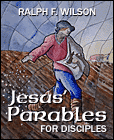
|

|
In-depth Bible study books
You can purchase one of Dr. Wilson's complete Bible studies in PDF, Kindle, or paperback format -- currently 48 books in the JesusWalk Bible Study Series.
Old Testament- Abraham, Faith of
- Jacob, Life of
- Moses the Reluctant Leader
- Joshua
- Gideon
- David, Life of
- Elijah
- Psalms
- Solomon
- Songs of Ascent (Psalms 120-134)
- Isaiah
- 28 Advent Scriptures (Messianic)
- Daniel
- Rebuild & Renew: Post-Exilic Books
Gospels
- Christmas Incarnation (Mt, Lk)
- Sermon on the Mount (Mt 5-7)
- Luke's Gospel
- John's Gospel
- Seven Last Words of Christ
- Parables
- Jesus and the Kingdom of God
- Resurrection and Easter Faith
- Apostle Peter
Acts
Pauline Epistles
- Romans 5-8 (Christ-Powered Life)
- 1 Corinthians
- 2 Corinthians
- Galatians
- Ephesians
- Philippians
- Colossians, Philemon
- 1 & 2 Thessalonians
- 1 &2 Timothy, Titus
General Epistles
Revelation
Topical
